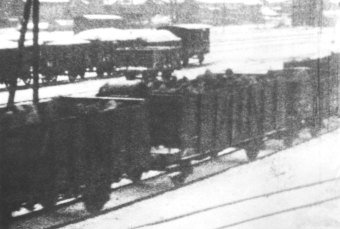Abandoning the Auschwitz Camp Complex: The Death March

© Fritz Bauer Institute (APMO Collection / Auschwitz-Birkenau State Museum)
The term “death march,” coined by prisoners of the concentration camps, refers to forced marches by large columns of prisoners under guard, during which the prisoners were brutally mistreated and hundreds of thousands were killed by the SS guards. Using administrative language, the SS euphemistically called the death marches Evakuierung, “evacuation.” The first death march took place in Poland in mid-January 1940, when about 800 Jewish prisoners of war, servicemen in the Polish army, were sent on a march of almost 100 kilometers (62 miles) in very low temperatures, guarded by mounted SS men. Only a few dozen survived. After Germany’s invasion of the Soviet Union in June 1941, the occupation troops forced hundreds of thousands of Soviet POWs to walk from the front to the camps in the rear area of the army group. The occupation authority also compelled the Jewish population to take part in death marches.
In 1944 and 1945, in light of the Red Army’s large-scale offensive in the East and the Allied landings in the West, the SS began vacating the concentration camps that were in the path of the advancing front, and deported the prisoners to areas that were still under German control. The objective was to keep exploiting the prisoners as a workforce for German industry. The marches lasted up to one month and often covered distances of hundreds of kilometers. All prisoners who fell behind were shot—often entire marching columns. In the cases in which the prisoners were loaded onto trains, with an average of 70 people jammed into a single freight car, they suffered from lack of oxygen, water, and food. In the winter of 1944/45, they froze by the hundreds in the trains. The exact number of people killed on the death marches is unknown. It is estimated that of the 750,000 concentration camp prisoners sent out on death marches in the war’s final weeks alone, between 250,000 and 375,000 were murdered. The brutal acts and killings frequently took place in the public streets, before the eyes of the German population.
The Auschwitz camps and their subcamps prepared for “evacuation” in January 1945. The Vistula-Oder Offensive of the Red Army began on January 12, 1945. On January 17, the commandant’s office began vacating the Neu-Dachs and Sosnowitz II subcamps, which were under the control of Auschwitz-Monowitz III. In the main camp, the post senior SS officer, Richard Baer, ordered the SS column leaders to vacate the Buna/Monowitz concentration camp, the main camp, and Birkenau.
Between January 17 and 21, about 56,000 prisoners from the main camp, Birkenau, Monowitz, and numerous subcamps were led westward in marching columns. About 9,000 completely exhausted or seriously ill prisoners and members of the inmate staff of the hospital barracks were left behind. A small number of relatively healthy prisoners even managed to ensconce themselves in hiding places, in the hope of speedy liberation by the Red Army.
Many men, women, and children died of exhaustion or froze to death. A far greater number, however, were killed by the SS guard escorts, who shot or beat to death anyone who lagged behind. Along the primary routes of the death march, about 3,000 corpses were left behind in the province of Upper Silesia, and to this day we have no verified information about the number of those killed along the routes through Lower Silesia and the northern regions of Moravia and Bohemia. Between January 19 and 23, a great part of the marching columns—approximately 35,000 to 40,000 prisoners—reached Gliwice (Gleiwitz) and Wodzisław Śląski (Loslau), where they were crammed into railroad freight cars and transported to concentration camps deeper inside the territory of the Reich. During the transports, which in some cases were made in open freight cars, hundreds of people died of exhaustion, thirst, hunger, or cold. Estimates of the number of people who died or were murdered during the clearing of the camp complex and the death marches from Auschwitz range from 9,000 to 15,000.
(FS; transl. KL)
















